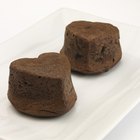
Souffles have an intimidating reputation as a demanding, finicky and easily bungled dish. Chefs are perfectly happy to let that reputation go unchallenged, because it means that home cooks are likely to relegate souffles to an occasional treat when eating out. In truth, they're no more difficult than any other dish. The key to a good souffle is whisking egg whites into a light, fluffy stable foam. Cream of tartar is often added to the eggs to help, but other ingredients can be substituted if necessary.
Understanding the Magic
Watching a souffle puff in the oven can almost seem magical, but it's surprisingly simple in its fundamentals. A souffle consists of two basic preparations. The first is a relatively thick and flavorful base, while the second is the whipped egg whites themselves. The base can be anything from a cheese sauce to a vegetable puree, depending on the souffle. It's there to give the souffle its taste and in some cases to lend a vivid color. It's the egg whites that give souffles their dramatic rise in the oven. The tiny air bubbles in the foamed eggs expand in the oven's heat, then set to a firm texture and hold the souffle in place until it's served.
What the Tartar Does
The success of a souffle depends largely on the cook's success in whipping the egg whites to a fine and dense foam, and that's where cream of tartar is valuable. Cream of tartar is a powdered form of tartaric acid, and its mild acidity helps unwind or "denature" the bonds that keep the eggs' protein molecules tightly bound together. As they unwind from their tight clusters, the proteins form extended chains of molecules that act as tiny balloons, trapping the air. The physical action of the whisk or beater can eventually accomplish the same thing, but acidity makes the process quicker and produces a longer-lasting foam.
Finding a Substitution
Cream of tartar is a useful ingredient, but it isn't something you'd always have on hand. If you find yourself making a souffle without it, you can achieve the same effect with other acidic ingredients. For example, a small squeeze of lemon juice or mild vinegar can denature the egg proteins just as well. They'll have a slight effect on the flavor of the egg whites, but it won't be detected in the finished souffle. In a pinch you can also use the powder sold in supermarket produce sections to keep cut fruit from turning brown. Most brands are crystallized ascorbic or citric acid, which will denature the proteins without adding a distinct flavor.
A Few More Tips
Aside from adding a pinch of acidity to the egg whites, there are a few other well-established ways to improve the height and stability of your foam. For one thing, egg whites whip much more effectively at room temperature. Leaving them out for an hour before you whip them and warming the mixing bowl both help tremendously. Consider getting a copper bowl for your stand mixer, because copper changes the egg whites' ionization and helps them whip more effectively. For the most stable foam, start your mixer at a low to moderate speed and only increase it to high speed once the foam is already light and fluffy.
Related Articles

Cream of Tartar Substitute for Egg ...

Adding Cream of Tartar to Macaroons

What Can I Use as an Egg Substitute ...

Cooking Yogurt Without Curdling It

What Can You Use in Place of Egg Yolk ...
What Do Bakeries Use in Their Whipped ...

Whole Eggs Vs. Egg Yolks for Sweet Bread

Can You Bake Greek Yogurt?

How to Fix Grainy Whipped Ganache

Baking Soda or Baking Powder to Make a ...

What Is a Souffle Dish?

How to Thicken a Lemon Filling in Baking

How Much Applesauce Do You Substitute ...

How to Mix Whipped Cream Cheese & ...

Ingredients in Dial Liquid Soap

What Can I Use as an Egg Substitute ...

Does Adding an Extra Egg to Brownie Mix ...

Can I Make Boxed Devil's Food Cake Mix ...

Can Self Rising Flour Substitute for ...

What Does Stabilizing Frosting Mean?
References
- The Professional Pastry Chef; Bo Friberg
- On Food and Cooking: The Science and Lore of the Kitchen; Harold McGee
Writer Bio
Fred Decker is a trained chef and prolific freelance writer. In previous careers, he sold insurance and mutual funds, and was a longtime retailer. He was educated at Memorial University of Newfoundland and the Northern Alberta Institute of Technology. His articles have appeared on numerous home and garden sites including GoneOutdoors, TheNest and eHow.
Photo Credits
Jupiterimages/Stockbyte/Getty Images